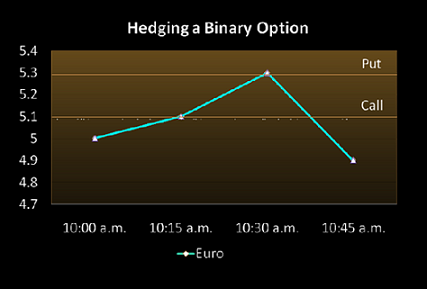Binary options are an interesting way to speculate on the markets. The idea that they pay all or nothing, regardless of how far the price moves, makes it easier to understand, but also more akin to gambling on the outcome, in this case the price at expiration. But what some don't realise is that you can also use binary options for hedging as well as speculation. In fact, some sharp traders use binary options for hedging profitable forex positions and for extending profitability in the case of small pullbacks. Hedging in this instance means using binary options in such a way that you come up with a way to lose only slightly while being open to higher gains.
Binary options have a strike price and expiration period, which may be as little as a few minutes or hours. If the price is above the strike price at expiration, a binary call option pays out the set amount; a put option would pay nothing. If the actual price is below the strike price at expiration, the binary call option is worthless, but a binary put option would pay out the agreed amount. The price of the option depends on how likely the outcome is, including how far in or out of the money the underlying is trading at present.
Hedging a binary option involves buying both a put and a call on the same financial instrument, with strike prices that allow both to be in the money at the same time. That is, the strike price of the binary call option is lower than the strike price of the binary put option.
Consider what this means. If the actual price is between the two strike prices at expiration, both the put and the call option would be in the money, and you would make a healthy profit over your premium outlaid. This is the best scenario, and all it requires is for the price to be in a range, the size of which is up to you. Admittedly, the larger the range, the more the binary options will have cost you, but that is part of your assessment on making the trade.
But because you have hedged your trade by taking both sides, with the call and the put, even if the price goes outside the range, all is not lost. Taking a single binary option would mean losing it all if it finished out of the money; but with this method, one of the options will still pay out regardless, cushioning the loss. You will still take a loss, as the premiums will be more than the payout of one single option, but the loss will be much less than it could have been.
In summary, to hedge with binary options, you buy a binary call option and a binary put option, with strike prices that overlap, so that at least one of them will pay out. You can win a greater amount than by taking just one option, and if you lose money you will lose far less than the straight loss that you would suffer with just one option. It’s a useful tool to add to your trading arsenal.
Here's a real-life example of a binary option hedge as highlighted on MarketsPulse.com. The scenario takes the case of a forex binary option on the price of the Euro. In this instance the Euro has been rising and is predicted to keep on rallying at a determined breakout point. At this level you would place a call, expecting the Euro to keep on rising. But what if the price changes direction and falls rapidly? You can place a put option at another point, helping you to minimize risk in the event that the price does indeed retrace.
 |
In the above scenario, you have placed a call for $500 at the option price of 5.1. You have also placed a put for $500 at the option price of 5.3.
The following outcomes could happen -:In each case, you stand a possibility of gaining a bigger profit by hedging, or placing two bets in opposite directions, as opposed to an all-or-nothing outcomes of one binary bet. In the instances in which you stand you lose money, you lose far less than the possibility you have to gain a greater profit than loss in other circumstances.